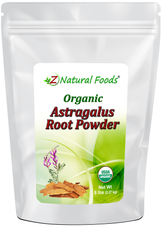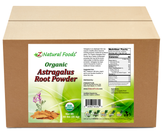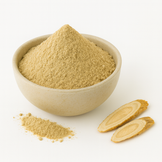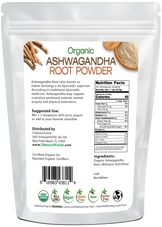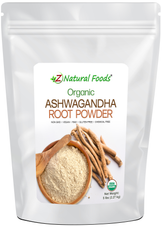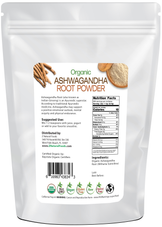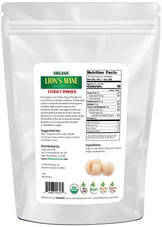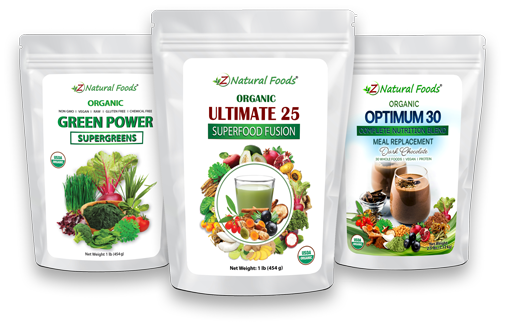Description
Description
Articles and videos on anti-aging and its related topics have become the most sought-after information in all areas of healthcare.
While many people want to look younger, the vast majority want to feel more youthful.
Before we discuss our three top categories of products at ZNaturalfoods.com for supporting a healthy aging process, it is vital to understand the difference between supporting a healthy aging process and the popular term “anti-aging” and epigenetics' critical role in this process.
The idea of reversing the aging process is considered controversial for many reasons.
Many cultures believe that elders in the community bring great wisdom and knowledge, and aging is man's most incredible achievement.
It is unclear if we will ever see the aging process stopped or reversed under the current paradigm of reductionist thinking.
Therefore, at Z Natural Foods, we believe a more obtainable goal (at least in the meantime) is to follow what many cultures have done for thousands of years:
Use what nature has provided to us to support and nourish a healthy aging process to live a long, happy, and fulfilling life.
Epigenetics: You don’t have to be a victim of your genetics
We have been made to believe that our genetics determine our fate, but this is not entirely true.
Epigenetics is the study of how our behavior and environment can cause changes that affect the way our genes work.
The research and development in the area of epigenetics began in the mid-1940s. Here are some interesting facts for you to sink your teeth into:
- In simple terms, epigenetics is how cells control gene activity without changing the DNA sequence.
- Epigenetic changes are modifications to DNA that regulate whether genes are turned on or off.
- Because epigenetic changes help determine whether genes are turned on or off, they influence the production of proteins in cells, which helps ensure that each cell produces only the proteins necessary for its function. For example, Muscle cells do not produce proteins that promote bone growth.
- Epigenetic modification patterns vary among individuals, in different tissues, within an individual, and even in other cells within a tissue.
- A genome is the complete set of the DNA in a cell; the modifications that regulate gene expression are called the epigenome.
- Environmental influences like diet and pollutant exposure can impact the epigenome.
- Epigenetic modification can be maintained from cell to cell as cells divide and, in some cases, can be inherited.
An article at Medline Plus titled What is Epigenetics discusses various examples of epigenetic modification to clarify the complex topic:
- One of the common types of epigenetic modification is DNA methylation, that involves the attachment of methyl groups to DNA building blocks. When they are presented on a gene, it is turned off or silenced, resulting in no protein being produced by that gene.
- Another standard epigenetic change is histone (structural protein in the cell nucleus) modification. DNA wraps around histones, which give chromosomes their shape. Chemical groups like methyl and acetyl can influence how tightly DNA wraps around histones and affect whether a gene can be turned on or off.
Neurogenesis and Neuroplasticity Defined
Another area of focus in the anti-aging world is the human brain. When discussing the aging brain, looking at neurogenesis and neuroplasticity is vital.
Neurogenesis is the growth and development of nerve tissue.
According to a review article in Frontiers, neurogenesis function, “The neural proliferate, migrate, and differentiate into mature neurons that eventually form the central nervous system.”
From what we know about this very complex process, neurogenesis may play a role in memory, learning systems, and protecting the brain from the pitfalls of chronic stress.
Neuroplasticity is “The ability of the nervous system to change its activity in response to intrinsic and extrinsic stimuli by reorganizing its structure, functions, or connections after injuries.”
Simply put, the brain can change and adapt due to experiences. It is finding a new way to the store or remembering someone’s name.
According to a conference paper, Evidence for Four Forms of Neuroplasticity,
we suggest that at least four significant forms of functional neuroplasticity can be studied in normal human subjects and patients. The four forms of functional neuroplasticity are:
- Homologous area adaptation assumes a particular cognitive process by a homologous region in the opposite hemisphere.
- Cross-modal reassignment occurs when structures previously devoted to processing a particular sensory input now accept input from a new sensory modality.
- Map expansion is the enlargement of a functional brain region based on performance.
- Compensatory masquerade is a novel allocation of a particular cognitive process to perform a task.
Focusing on these four forms of functional neuroplasticity can address several fundamental questions about how functional cooperation between brain regions is achieved.”
Healthy Aging: A TCM Perspective
TCM principles dictate there are many factors to living a healthy and fulfilling life.
Some of those factors include lifestyle, your constitution, the level to which you take proactive measures, your ability to avoid and adapt to external stressors, and a little bit of luck.
In TCM, one’s constitution is measured in life force, aka Jing.
If your Jing is naturally substantial (meaning you are more vibrant, resilient, and robust), it means you have won the genetic lottery and have a better shot at living a long and rich life, or so we thought.
In simple terms, we have learned from science, tradition, and a little common sense that those with a strong constitution due to good genetics are equally vulnerable to dying young, with the primary culprit being an unbalanced lifestyle. This one factor alone can strongly deplete one’s Jing whether or not they have strong genetics.
Now, let’s look at three of the best natural foods and their categories that can support a healthy aging process.
Top Three Natural Foods that Support a Healthy Aging Process
Major Tonic Herbs
Major or primary tonic herbs are plants or, in some cases, animal part extracts that have been heavily used for thousands of years, considered prized in tonic herbalism, and support and nourish at least one of the three treasures based on TCM principles.
Some primary tonic herbs include:
- Reishi,
- Goji berries,
- Astragalus,
- He Shou Wu,
- Schizandra berries,
- Eucommia,
- Ginseng, and
- Gynostemia.
Tonic herbs are defined based on function and criteria. In simple terms, four primary fundamental aspects define a tonic herb.
- They create and support a state of physical, mental, and emotional well-being through the appropriate balance of Yin and Yang energy to attain vibrant health.
- They can be used for an unlimited period with no adverse effects.
- No matter how long an individual uses tonic herbs, they never build a tolerance.
- True tonics come from their authentic source and spiritual homeland. This principle is known in Daoist herbalism as Di Tao and makes a vital difference in potency and efficacy.
All tonic herbs nourish at least one of what TCM calls The Three Treasures.
The three treasures are interconnected and contribute to overall health and well-being. They are as follows:
- Jing is essence primarily stored in the kidneys. Jing is one’s constitution, regulates the body’s growth and development, and works with Qi to protect the body from harmful external conditions. Poor constitution, blood loss, and excessive sexual activity can cause jing essence deficiencies.
- Qi is a life force or vital energy stored in the kidneys. Both the physical and emotional are manifested as Qi. One is inherited from our parents, and the second is derived from essential substances like air, food, and water. Deficiencies are caused by poor nutrition and digestion, chronic stress, and constrained breathing.
- Shen is the emotional and spirit layer of our being that reflects the state of our nervous system. Shen lives in the heart and is said to “preside over the activities that take place in the spiritual and mental planes.” Because Shen lives in the heart, people with disturbed Shen may experience anxiety, stress, difficulty breathing, and insomnia. In such cases, the primary weakness is from the spleen, which cannot generate enough blood to nourish the heart and anchor the Shen.
There are four primary categories of tonic herbs:
- Qi Tonics: Also known as energy tonics, with a primary function of increasing energy production. TCM believes they enhance nutrient absorption, yielding blood and energy. They are traditionally used to support metabolic processes, influence the spleen, and nurture the lungs.
- Blood Tonics: These are known to nourish and balance blood via optimizing nutrient utilization. Blood nourishes the tissues and provides a means of distribution for nutrients, hormones, and immune cells. Blood tonics are commonly used to support the quality of one’s skin. Some blood tonics also work as blood vitalizers to improve microcirculation.
- Yin Tonics: Yin is the accumulation of storage and energy condensed in all body tissues, primarily in all significant organs, specifically within the kidneys. The stored energy in the kidneys is known as the Yin essence and is considered the body’s fundamental reserve. Yin tonics are associated with preserving the quality of life.
- Yang Tonics: Yang is the utilization of stored energy (Yin). Yang tonics have a warm or hot power, are associated with creativity, and are therefore believed to build strength and courage. Yang herbs are used to stimulate metabolism, build muscle, and support the skeletal system.
For more information about tonics, go here:
Does cordyceps mushroom powder work? (+medicinals vs tonics)
Understanding that tonic herbs are not used to treat or prevent specific issues is vital. They promote and support general well-being by enhancing energy and regulating function.
The priority is not about healing but gently promoting one’s health. Tonic herbs provide adaptive Qi, allowing us to deal with daily stressors more efficiently. Ultimately, this will enable us to grow as human beings.
For more information about one of our favorite major tonic herbs, go here:
Organic Astragalus Root Powder
Adaptogens
Adaptogens are a supportive tool for managing a healthy stress response through nonspecific physiological reactions.
What makes all adaptogens unique is their ability to adapt to the harsh conditions in which they are grown. This adaptability allows them to thrive and become robust plants. As the research on adaptogens has been compiled over the years, herbalists and scientists have learned and concluded how each adaptogen's energy (warming, cooling, drying, moistening) and constituents balance has allowed them to be used in a more specific targeted approach.
For example, there are calming adaptogens and stimulating adaptogens. Furthermore, it is common to use companion herbs like nervines to support the nervous system further.
Plants and fungi are often categorized based on their functional qualities. Unfortunately, many plants and fungi are called adaptogens even though they don’t fulfill the criteria that define an adaptogen.
Therefore, it is essential to understand the requirements for how an adaptogen is defined and how they work. The following are primary points that define what a plant or fungi must do to be considered an adaptogen.
Adaptogens must:
- Be nontoxic at clinical dosage
- Increase the resistance of the hormonal and immune systems to all kinds of stressors through a nonspecific physiological response.
- Normalize body function no matter how external stressors have altered them.
We have learned that what makes plants and fungi actual adaptogens is that they must work through one or both of the body’s master control systems.
1) The HPA Axis (Hypothalamic-Pituitary-Adrenal Axis) is a complex system of neuroendocrine pathways and feedback loops that maintain and support homeostasis in response to chronic stress. The HPA axis interfaces the endocrine, nervous, immune, digestive, reproductive, and cardio systems.
2) The SAS (Sympatho Adrenal system, aka fight or flight) is a complex system that connects the sympathetic nervous system to the adrenal medulla. In simple terms, it is our fight-or-flight response. A triggered response floods our system with adrenalin and releases hormones epinephrine and norepinephrine from the adrenal medulla. This response increases blood pressure, blood sugar, and heart rate and suppresses digestion. This releasing of hormones and redistribution of blood allows the mind and body to respond and survive.
Based on the above criteria, there are currently only nine “true” adaptogens:
For more information about adaptogens, go here:
It should be noted that the plants that fulfill part of the criteria are considered possible adaptogens—for example, Holy basil or Maca root.
It is a common mistake to think that tonics and adaptogens are identical.
While tonics and adaptogens are defined based on different criteria and are ultimately separate entities, some overlap exists.
For example, Qi tonics fulfill the requirements for what Western herbalism defines as an adaptogen. So, in simple terms, while Qi tonics meet the requirements as an adaptogen, Western adaptogens do not fulfill the criteria for being a tonic. The primary reason is that we often build a tolerance for Western adaptogens. This usually requires a break or the rotation of herbs to prevent this common issue.
In some cases, it may not be the herb itself but the species of the herb. For example, a commonly used adaptogen is Rhodiola.
The species most widely used and spoken about is Siberian Rhodiola. While it is a very effective herb, this species has several issues. First, people build a tolerance to it, so it can not be used for an extended period without taking a break. Next, it can be very stimulating, warming, and drying, so if used by individuals who manifest excessive heat or aggressiveness, it may exacerbate this issue.
On the other hand, Tibetan Rhodiola is commonly used in tonic herbalism because it has a more balanced effect, and we don’t build a tolerance to it.
For more information about one of our favorite adaptogen herbs, go here:
Medicinal Mushrooms
Polysaccharides are believed to be mushrooms' primary family of compounds that may support a healthy aging process.
Mushrooms contain a wide range of non-starch polysaccharides (carbohydrate fractions excluding starch and free sugar) like:
- chitin,
- beta-glucans,
- alpha-glucans,
- hemicellulose,
- mannans,
- xylans, and
- galactan's.
Non-starch polysaccharides are distinguished into soluble and insoluble fractions, with up to 90% being insoluble fractions.
Most (around 80%) of insoluble polysaccharides are chitin, including beta-glucans bound onto chitin or protein. Polysaccharides can support a wide range of actions in the human body. They have been shown to have immunological, neurogenic, cardiovascular, and microbiome effects and a host of other nourishing qualities.
Until recently, it was believed that the primary polysaccharides found in fungi are beta-D-glucans, which come in various forms (beta 1-3 and 1-6) are the powerhouse for what makes mushrooms work.
Other polysaccharides found in mushrooms are Alpha-glucans like glycogen, dextran, pullulan, and starch, which, for a long time, were not thought to provide the same nourishing qualities as beta-glucans. Modern research has taught us that this belief tells you only part of the story and may be based on flawed science. While beta-glucans are potent compounds, there are hundreds of beta-glucan shapes and sizes, and while some are biologically active, others are not. Furthermore, not all are immunologically active. Ultimately, they are just one variable of a wide range of compounds responsible for a mushroom's many nourishing qualities.
For more information about the polysaccharides in mushrooms, go here:
Types of polysaccharides in mushrooms (+beta-glucan facts)
Therefore, It is misleading to state that beta-glucan levels are the determining factor in the effectiveness of a mushroom product. Beta-glucans are most effective when they work with all other constituents found in mushrooms, and if one or more are missing, it can change how effectively the end product works.
For example, a study discussing the polysaccharide K from turkey tail mushrooms showed that when lipase was applied, it reduced the immunological response of PSK by 80%. This shows the importance of the associated lipids bound to the beta-glucans and that their independent presence is insufficient to obtain maximal benefits.
Each species of fungi may contain a different beta-glucan.
For example, Lion’s Mane mushrooms contain many bioactive compounds like
Polysaccharides, Polypeptides, Prebiotic fiber, Hericenones, and Erinacines. Some of these bioactive compounds have been linked to neurogenesis (The growth and development of nerve tissue) because preliminary research on Lion’s Mane suggests its potential to support this process by possibly preventing and repairing nerve damage.
Hericenones and Erinacines have been shown to cross the blood-brain barrier, potentially stimulating nerve growth factor (A protein that plays a role in the maintenance, survival, and regeneration of neurons), which benefits those at high risk for brain injury.
In a small double-blind, placebo-controlled human study understanding the effects Lion’s Mane mushrooms (Yamabushitake) have on mild cognitive impairment, “ At weeks 8, 12 and 16 of the trial, the Yamabushitake group showed significantly increased scores on the cognitive function scale compared with the placebo group. The Yamabushitake group's scores increased with the duration of intake, but at week 4, after the termination of the 16 weeks of intake, the scores decreased significantly. Laboratory tests showed no adverse effect of Yamabushitake. The results obtained in this study suggest that Yamabushitake is effective in improving mild cognitive impairment.”
For more information about one of our favorite Medicinal Mushrooms, go here:
In conclusion, the world of anti-aging is a very complex area of research with many moving parts and nowhere near a real solution to stopping or reversing the aging process.
The above categories of plant and fungal medicine have a long documented history and a massive pool of research proving their ability to nourish and support all aspects of the aging process.
Therefore, using what Mother Nature provided may be the real solution for living a long, healthy, and vibrant life.





